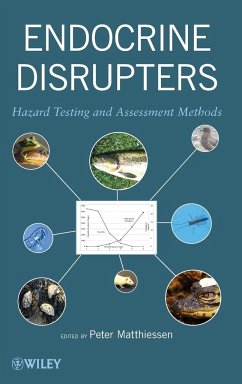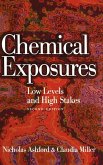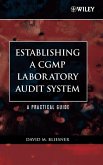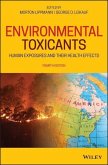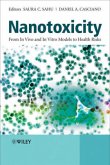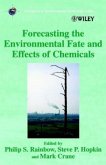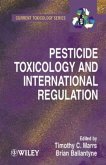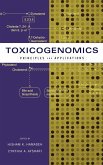Peter Matthiessen
Endocrine Disrupters
Peter Matthiessen
Endocrine Disrupters
- Gebundenes Buch
- Merkliste
- Auf die Merkliste
- Bewerten Bewerten
- Teilen
- Produkt teilen
- Produkterinnerung
- Produkterinnerung
This book describes methodology and applications for endocrine disrupter toxicity testing, an issue of considerable urgency, because of international regulatory authorities currently considering such testing schemes. The coverage examines major animal groups for sensitivity to endocrine disrupting chemicals (EDCs), identifying endpoints and procedures for testing guidelines. Three EDC screening methods (two using fish and one using amphibians) are examined in detail for their efficacy and applicability. Edited by, and with contributions from, a leading participant in regulatory efforts, the…mehr
Andere Kunden interessierten sich auch für
![Chemical Exposures Chemical Exposures]() Nicholas A. AshfordChemical Exposures162,99 €
Nicholas A. AshfordChemical Exposures162,99 €![Establishing a Cgmp Laboratory Audit System Establishing a Cgmp Laboratory Audit System]() David M. BliesnerEstablishing a Cgmp Laboratory Audit System163,99 €
David M. BliesnerEstablishing a Cgmp Laboratory Audit System163,99 €![Environmental Toxicants Environmental Toxicants]() Environmental Toxicants279,99 €
Environmental Toxicants279,99 €![Nanotoxicity Nanotoxicity]() Nanotoxicity281,99 €
Nanotoxicity281,99 €![Forecasting the Environmental Fate and Effects of Chemicals Forecasting the Environmental Fate and Effects of Chemicals]() Philip S. Rainbow / Steve P. Hopkin / Mark Crane (Hgg.)Forecasting the Environmental Fate and Effects of Chemicals352,99 €
Philip S. Rainbow / Steve P. Hopkin / Mark Crane (Hgg.)Forecasting the Environmental Fate and Effects of Chemicals352,99 €![Pesticide Toxicology and International Regulation Pesticide Toxicology and International Regulation]() Timothy C. Marrs / Bryan Ballantyne (Hgg.)Pesticide Toxicology and International Regulation375,99 €
Timothy C. Marrs / Bryan Ballantyne (Hgg.)Pesticide Toxicology and International Regulation375,99 €![Toxicogenomics Toxicogenomics]() Toxicogenomics165,99 €
Toxicogenomics165,99 €-
-
-
This book describes methodology and applications for endocrine disrupter toxicity testing, an issue of considerable urgency, because of international regulatory authorities currently considering such testing schemes. The coverage examines major animal groups for sensitivity to endocrine disrupting chemicals (EDCs), identifying endpoints and procedures for testing guidelines. Three EDC screening methods (two using fish and one using amphibians) are examined in detail for their efficacy and applicability. Edited by, and with contributions from, a leading participant in regulatory efforts, the book outlines methods that combine sensitivity, efficiency, statistical power, acceptable cost, and minimum ethical concern.
Hinweis: Dieser Artikel kann nur an eine deutsche Lieferadresse ausgeliefert werden.
Hinweis: Dieser Artikel kann nur an eine deutsche Lieferadresse ausgeliefert werden.
Produktdetails
- Produktdetails
- Verlag: Wiley & Sons
- 1. Auflage
- Seitenzahl: 416
- Erscheinungstermin: 25. März 2013
- Englisch
- Abmessung: 240mm x 161mm x 27mm
- Gewicht: 712g
- ISBN-13: 9780470932094
- ISBN-10: 0470932090
- Artikelnr.: 34745139
- Herstellerkennzeichnung
- Libri GmbH
- Europaallee 1
- 36244 Bad Hersfeld
- gpsr@libri.de
- Verlag: Wiley & Sons
- 1. Auflage
- Seitenzahl: 416
- Erscheinungstermin: 25. März 2013
- Englisch
- Abmessung: 240mm x 161mm x 27mm
- Gewicht: 712g
- ISBN-13: 9780470932094
- ISBN-10: 0470932090
- Artikelnr.: 34745139
- Herstellerkennzeichnung
- Libri GmbH
- Europaallee 1
- 36244 Bad Hersfeld
- gpsr@libri.de
PETER MATTHIESSEN, PhD, is an aquatic ecotoxicologist who works as an independent consultant. Specializing in the study of endocrine disrupters, he has conducted extensive research into how sewage effluents cause feminization in wild male fish as well as how tributyltin-based antifoulants cause masculinization in wild female mollusks. Professor Matthiessen is a member of the UK Advisory Committee on Pesticides and Co-chair of the OECD Validation Management Group for Ecotoxicity Tests. He has contributed to the development of standardized ecotoxicity assays with sensitivity for endocrine disrupters as well as written guidance for the interpretation of the resulting data.
Preface ix
Contributors xi
1 Ecotoxicity Test Methods for Endocrine-Disrupting Chemicals: An
Introduction 1
Peter Matthiessen
1.1 Background 1
1.2 Regulatory Concerns 2
1.3 Invertebrates 2
1.4 Vertebrates 3
1.5 Testing Schemes for EDCs 5
Reference 6
2 Endocrine Disruption inWildlife: Background, Effects, and Implications 7
Dick Vethaak and Juliette Legler
2.1 Background to Endocrine Disruption 8
2.2 Effects of EDCs on Wildlife 19
2.3 Weight of Evidence and Ecological Significance of ED Effects 32
2.4 Implications for Effect Assessment and Toxicity Testing 36
2.5 Need for More Field Studies and an Integrated Approach 38
2.6 Concluding Points 39
References 40
3 The Regulatory Need for Tests to Detect EDCs and Assess Their Hazards
toWildlife 59
Hans-Christian Stolzenberg, Tobias Frische, Vicki L. Dellarco, Gary Timm,
Anne Gourmelon, Taisen Iguchi, Flemming Ingerslev, and Mike Roberts
3.1 Emerging Concerns and Policy Responses: Focusing on EDCs as a Large
Pseudo-Uniform Group of Substances 60
3.2 General Approaches in Substance-Related Regulatory Frameworks (EU) 80
3.3 How to Make EDC Definitions Operational for Substance-Related
Regulatory Work 87
3.4 Future Perspectives 91
3.5 Conclusions 92
References 93
4 Techniques for Measuring Endocrine Disruption in Insects 100
Lennart Weltje
4.1 Introduction 100
4.2 Methods 105
4.3 Discussion 108
4.4 Conclusion 110
4.5 Acknowledgments 110
References 110
5 Crustaceans 116
Magnus Breitholtz
5.1 Introduction 116
5.2 Background to Crustacean Endocrinology 118
5.3 State of the Art: What Do We Know About Endocrine Disruption in
Crustaceans? 121
5.4 Available Subchronic/Chronic Standard Test Protocols 128
5.5 Complementary Tools for Identification of Endocrine Disruption 129
5.6 Summary and Conclusions 132
References 134
6 Endocrine Disruption in Molluscs: Processes and Testing 143
Patricia D. McClellan-Green
6.1 Background and Introduction 143
6.2 What Constitutes the Endocrine System in Molluscs? 145
6.3 End Points and Biomarkers of Endocrine Disruption 154
6.4 Current Test Methods Using Molluscs 164
6.5 Proposed Test Methods 167
6.6 Conclusions 171
References 172
7 Using Fish to Detect Endocrine Disrupters and Assess Their Potential
Environmental Hazards 185
Peter Matthiessen
7.1 Introduction 185
7.2 International Efforts to Standardize Fish-Based Methods for Screening
and Testing Endocrine-Disrupting
7.3 Fish-Based Screens Developed by OECD for Endocrine-Disrupting Chemicals
189
7.4 Progress with Developing Fish Partial Life Cycle Tests for Endocrine
Disrupters 194
7.5 Prospects for the Standardization of Fish Full Life Cycle and
Multigeneration Tests 195
7.6 Strengths and Weaknesses of a Hazard Evaluation Strategy Based Partly
on Available and Proposed Fish Screens and Tests 197
7.7 Conclusions 198
References 198
8 Screening and Testing for Endocrine-Disrupting Chemicals in Amphibian
Models 202
Daniel B. Pickford
8.1 Introduction 202
8.2 Potential Uses of Amphibians in Endocrine Disrupter Screening and
Testing Programs 203
8.3 Embryonic Development 205
8.4 Hatching 208
8.5 Larval Development 209
8.6 Higher-Tier Tests with Amphibians 224
8.7 Other and Emerging Test Methods 227
8.8 Summary and Conclusions 229
References 232
9 Endocrine Disruption and Reptiles: Using the Unique Attributes of
Temperature-Dependent Sex Determination to Assess Impacts 245
Satomi Kohno and Louis J. Guillette, Jr.
9.1 Introduction 245
9.2 Approaches to Examine Effects of EDCs 252
9.3 Induction of Sex Reversal In Ovo 255
9.4 Analysis of Sex-Reversed Animals 260
9.5 Conclusions 265
References 266
10 Birds 272
Paul D. Jones, Markus Hecker, Steve Wiseman, and John P. Giesy
10.1 Introduction 272
10.2 Differences Between Birds and Mammals and Among Bird Species 275
10.3 In Vitro Techniques 278
10.4 Studies with Embryos 280
10.5 In Vivo Techniques 280
10.6 Examples of EDC Effects from Field Studies 285
10.7 Proposed Two-Generation Test 288
10.8 Conclusions 291
References 292
11 Mammalian Methods for Detecting and Assessing Endocrine-Active Compounds
304
M. Sue Marty
11.1 Introduction 304
11.2 Mammalian Tier 1 Screening Assays 306
11.3 Tier 2 Tests 326
11.4 Human and Wildlife Relevance of Estrogen, Androgen, and Thyroid
Screening Assays 329
11.5 Potential Future Assays for Endocrine Screening 330
References 332
12 Application of the OECD Conceptual Framework for Assessing the Human
Health and Ecological Effects of Endocrine Disrupters 341
Thomas H. Hutchinson, Jenny Odum, and Anne Gourmelon
12.1 Introduction 342
12.2 Overview of the OECD Revised CF 343
12.3 Application of the Klimisch Criteria to the EE2 and VIN Case Studies
346
12.4 Case Study: Data Examples for 17-Ethynylestradiol 346
12.5 Case Study: Data Examples for Vinclozolin 357
12.6 Conclusions 367
References 368
13 The Prospects for Routine Testing of Chemicals for Endocrine-Disrupting
Properties and Potential Ecological Impacts 373
Peter Matthiessen
13.1 Introduction 373
13.2 Are There Gaps in the Test Suite for EDCs? 374
13.3 "New" Modes of Endocrine-Disrupting Action 376
13.4 How Should Tests for EDCs Be Deployed in an Integrated Fashion? 377
13.5 Use of Weight of Evidence when Assessing Possible EDCs 380
13.6 Conclusions 382
References 382
Index 385
Contributors xi
1 Ecotoxicity Test Methods for Endocrine-Disrupting Chemicals: An
Introduction 1
Peter Matthiessen
1.1 Background 1
1.2 Regulatory Concerns 2
1.3 Invertebrates 2
1.4 Vertebrates 3
1.5 Testing Schemes for EDCs 5
Reference 6
2 Endocrine Disruption inWildlife: Background, Effects, and Implications 7
Dick Vethaak and Juliette Legler
2.1 Background to Endocrine Disruption 8
2.2 Effects of EDCs on Wildlife 19
2.3 Weight of Evidence and Ecological Significance of ED Effects 32
2.4 Implications for Effect Assessment and Toxicity Testing 36
2.5 Need for More Field Studies and an Integrated Approach 38
2.6 Concluding Points 39
References 40
3 The Regulatory Need for Tests to Detect EDCs and Assess Their Hazards
toWildlife 59
Hans-Christian Stolzenberg, Tobias Frische, Vicki L. Dellarco, Gary Timm,
Anne Gourmelon, Taisen Iguchi, Flemming Ingerslev, and Mike Roberts
3.1 Emerging Concerns and Policy Responses: Focusing on EDCs as a Large
Pseudo-Uniform Group of Substances 60
3.2 General Approaches in Substance-Related Regulatory Frameworks (EU) 80
3.3 How to Make EDC Definitions Operational for Substance-Related
Regulatory Work 87
3.4 Future Perspectives 91
3.5 Conclusions 92
References 93
4 Techniques for Measuring Endocrine Disruption in Insects 100
Lennart Weltje
4.1 Introduction 100
4.2 Methods 105
4.3 Discussion 108
4.4 Conclusion 110
4.5 Acknowledgments 110
References 110
5 Crustaceans 116
Magnus Breitholtz
5.1 Introduction 116
5.2 Background to Crustacean Endocrinology 118
5.3 State of the Art: What Do We Know About Endocrine Disruption in
Crustaceans? 121
5.4 Available Subchronic/Chronic Standard Test Protocols 128
5.5 Complementary Tools for Identification of Endocrine Disruption 129
5.6 Summary and Conclusions 132
References 134
6 Endocrine Disruption in Molluscs: Processes and Testing 143
Patricia D. McClellan-Green
6.1 Background and Introduction 143
6.2 What Constitutes the Endocrine System in Molluscs? 145
6.3 End Points and Biomarkers of Endocrine Disruption 154
6.4 Current Test Methods Using Molluscs 164
6.5 Proposed Test Methods 167
6.6 Conclusions 171
References 172
7 Using Fish to Detect Endocrine Disrupters and Assess Their Potential
Environmental Hazards 185
Peter Matthiessen
7.1 Introduction 185
7.2 International Efforts to Standardize Fish-Based Methods for Screening
and Testing Endocrine-Disrupting
7.3 Fish-Based Screens Developed by OECD for Endocrine-Disrupting Chemicals
189
7.4 Progress with Developing Fish Partial Life Cycle Tests for Endocrine
Disrupters 194
7.5 Prospects for the Standardization of Fish Full Life Cycle and
Multigeneration Tests 195
7.6 Strengths and Weaknesses of a Hazard Evaluation Strategy Based Partly
on Available and Proposed Fish Screens and Tests 197
7.7 Conclusions 198
References 198
8 Screening and Testing for Endocrine-Disrupting Chemicals in Amphibian
Models 202
Daniel B. Pickford
8.1 Introduction 202
8.2 Potential Uses of Amphibians in Endocrine Disrupter Screening and
Testing Programs 203
8.3 Embryonic Development 205
8.4 Hatching 208
8.5 Larval Development 209
8.6 Higher-Tier Tests with Amphibians 224
8.7 Other and Emerging Test Methods 227
8.8 Summary and Conclusions 229
References 232
9 Endocrine Disruption and Reptiles: Using the Unique Attributes of
Temperature-Dependent Sex Determination to Assess Impacts 245
Satomi Kohno and Louis J. Guillette, Jr.
9.1 Introduction 245
9.2 Approaches to Examine Effects of EDCs 252
9.3 Induction of Sex Reversal In Ovo 255
9.4 Analysis of Sex-Reversed Animals 260
9.5 Conclusions 265
References 266
10 Birds 272
Paul D. Jones, Markus Hecker, Steve Wiseman, and John P. Giesy
10.1 Introduction 272
10.2 Differences Between Birds and Mammals and Among Bird Species 275
10.3 In Vitro Techniques 278
10.4 Studies with Embryos 280
10.5 In Vivo Techniques 280
10.6 Examples of EDC Effects from Field Studies 285
10.7 Proposed Two-Generation Test 288
10.8 Conclusions 291
References 292
11 Mammalian Methods for Detecting and Assessing Endocrine-Active Compounds
304
M. Sue Marty
11.1 Introduction 304
11.2 Mammalian Tier 1 Screening Assays 306
11.3 Tier 2 Tests 326
11.4 Human and Wildlife Relevance of Estrogen, Androgen, and Thyroid
Screening Assays 329
11.5 Potential Future Assays for Endocrine Screening 330
References 332
12 Application of the OECD Conceptual Framework for Assessing the Human
Health and Ecological Effects of Endocrine Disrupters 341
Thomas H. Hutchinson, Jenny Odum, and Anne Gourmelon
12.1 Introduction 342
12.2 Overview of the OECD Revised CF 343
12.3 Application of the Klimisch Criteria to the EE2 and VIN Case Studies
346
12.4 Case Study: Data Examples for 17-Ethynylestradiol 346
12.5 Case Study: Data Examples for Vinclozolin 357
12.6 Conclusions 367
References 368
13 The Prospects for Routine Testing of Chemicals for Endocrine-Disrupting
Properties and Potential Ecological Impacts 373
Peter Matthiessen
13.1 Introduction 373
13.2 Are There Gaps in the Test Suite for EDCs? 374
13.3 "New" Modes of Endocrine-Disrupting Action 376
13.4 How Should Tests for EDCs Be Deployed in an Integrated Fashion? 377
13.5 Use of Weight of Evidence when Assessing Possible EDCs 380
13.6 Conclusions 382
References 382
Index 385
Preface ix
Contributors xi
1 Ecotoxicity Test Methods for Endocrine-Disrupting Chemicals: An
Introduction 1
Peter Matthiessen
1.1 Background 1
1.2 Regulatory Concerns 2
1.3 Invertebrates 2
1.4 Vertebrates 3
1.5 Testing Schemes for EDCs 5
Reference 6
2 Endocrine Disruption inWildlife: Background, Effects, and Implications 7
Dick Vethaak and Juliette Legler
2.1 Background to Endocrine Disruption 8
2.2 Effects of EDCs on Wildlife 19
2.3 Weight of Evidence and Ecological Significance of ED Effects 32
2.4 Implications for Effect Assessment and Toxicity Testing 36
2.5 Need for More Field Studies and an Integrated Approach 38
2.6 Concluding Points 39
References 40
3 The Regulatory Need for Tests to Detect EDCs and Assess Their Hazards
toWildlife 59
Hans-Christian Stolzenberg, Tobias Frische, Vicki L. Dellarco, Gary Timm,
Anne Gourmelon, Taisen Iguchi, Flemming Ingerslev, and Mike Roberts
3.1 Emerging Concerns and Policy Responses: Focusing on EDCs as a Large
Pseudo-Uniform Group of Substances 60
3.2 General Approaches in Substance-Related Regulatory Frameworks (EU) 80
3.3 How to Make EDC Definitions Operational for Substance-Related
Regulatory Work 87
3.4 Future Perspectives 91
3.5 Conclusions 92
References 93
4 Techniques for Measuring Endocrine Disruption in Insects 100
Lennart Weltje
4.1 Introduction 100
4.2 Methods 105
4.3 Discussion 108
4.4 Conclusion 110
4.5 Acknowledgments 110
References 110
5 Crustaceans 116
Magnus Breitholtz
5.1 Introduction 116
5.2 Background to Crustacean Endocrinology 118
5.3 State of the Art: What Do We Know About Endocrine Disruption in
Crustaceans? 121
5.4 Available Subchronic/Chronic Standard Test Protocols 128
5.5 Complementary Tools for Identification of Endocrine Disruption 129
5.6 Summary and Conclusions 132
References 134
6 Endocrine Disruption in Molluscs: Processes and Testing 143
Patricia D. McClellan-Green
6.1 Background and Introduction 143
6.2 What Constitutes the Endocrine System in Molluscs? 145
6.3 End Points and Biomarkers of Endocrine Disruption 154
6.4 Current Test Methods Using Molluscs 164
6.5 Proposed Test Methods 167
6.6 Conclusions 171
References 172
7 Using Fish to Detect Endocrine Disrupters and Assess Their Potential
Environmental Hazards 185
Peter Matthiessen
7.1 Introduction 185
7.2 International Efforts to Standardize Fish-Based Methods for Screening
and Testing Endocrine-Disrupting
7.3 Fish-Based Screens Developed by OECD for Endocrine-Disrupting Chemicals
189
7.4 Progress with Developing Fish Partial Life Cycle Tests for Endocrine
Disrupters 194
7.5 Prospects for the Standardization of Fish Full Life Cycle and
Multigeneration Tests 195
7.6 Strengths and Weaknesses of a Hazard Evaluation Strategy Based Partly
on Available and Proposed Fish Screens and Tests 197
7.7 Conclusions 198
References 198
8 Screening and Testing for Endocrine-Disrupting Chemicals in Amphibian
Models 202
Daniel B. Pickford
8.1 Introduction 202
8.2 Potential Uses of Amphibians in Endocrine Disrupter Screening and
Testing Programs 203
8.3 Embryonic Development 205
8.4 Hatching 208
8.5 Larval Development 209
8.6 Higher-Tier Tests with Amphibians 224
8.7 Other and Emerging Test Methods 227
8.8 Summary and Conclusions 229
References 232
9 Endocrine Disruption and Reptiles: Using the Unique Attributes of
Temperature-Dependent Sex Determination to Assess Impacts 245
Satomi Kohno and Louis J. Guillette, Jr.
9.1 Introduction 245
9.2 Approaches to Examine Effects of EDCs 252
9.3 Induction of Sex Reversal In Ovo 255
9.4 Analysis of Sex-Reversed Animals 260
9.5 Conclusions 265
References 266
10 Birds 272
Paul D. Jones, Markus Hecker, Steve Wiseman, and John P. Giesy
10.1 Introduction 272
10.2 Differences Between Birds and Mammals and Among Bird Species 275
10.3 In Vitro Techniques 278
10.4 Studies with Embryos 280
10.5 In Vivo Techniques 280
10.6 Examples of EDC Effects from Field Studies 285
10.7 Proposed Two-Generation Test 288
10.8 Conclusions 291
References 292
11 Mammalian Methods for Detecting and Assessing Endocrine-Active Compounds
304
M. Sue Marty
11.1 Introduction 304
11.2 Mammalian Tier 1 Screening Assays 306
11.3 Tier 2 Tests 326
11.4 Human and Wildlife Relevance of Estrogen, Androgen, and Thyroid
Screening Assays 329
11.5 Potential Future Assays for Endocrine Screening 330
References 332
12 Application of the OECD Conceptual Framework for Assessing the Human
Health and Ecological Effects of Endocrine Disrupters 341
Thomas H. Hutchinson, Jenny Odum, and Anne Gourmelon
12.1 Introduction 342
12.2 Overview of the OECD Revised CF 343
12.3 Application of the Klimisch Criteria to the EE2 and VIN Case Studies
346
12.4 Case Study: Data Examples for 17-Ethynylestradiol 346
12.5 Case Study: Data Examples for Vinclozolin 357
12.6 Conclusions 367
References 368
13 The Prospects for Routine Testing of Chemicals for Endocrine-Disrupting
Properties and Potential Ecological Impacts 373
Peter Matthiessen
13.1 Introduction 373
13.2 Are There Gaps in the Test Suite for EDCs? 374
13.3 "New" Modes of Endocrine-Disrupting Action 376
13.4 How Should Tests for EDCs Be Deployed in an Integrated Fashion? 377
13.5 Use of Weight of Evidence when Assessing Possible EDCs 380
13.6 Conclusions 382
References 382
Index 385
Contributors xi
1 Ecotoxicity Test Methods for Endocrine-Disrupting Chemicals: An
Introduction 1
Peter Matthiessen
1.1 Background 1
1.2 Regulatory Concerns 2
1.3 Invertebrates 2
1.4 Vertebrates 3
1.5 Testing Schemes for EDCs 5
Reference 6
2 Endocrine Disruption inWildlife: Background, Effects, and Implications 7
Dick Vethaak and Juliette Legler
2.1 Background to Endocrine Disruption 8
2.2 Effects of EDCs on Wildlife 19
2.3 Weight of Evidence and Ecological Significance of ED Effects 32
2.4 Implications for Effect Assessment and Toxicity Testing 36
2.5 Need for More Field Studies and an Integrated Approach 38
2.6 Concluding Points 39
References 40
3 The Regulatory Need for Tests to Detect EDCs and Assess Their Hazards
toWildlife 59
Hans-Christian Stolzenberg, Tobias Frische, Vicki L. Dellarco, Gary Timm,
Anne Gourmelon, Taisen Iguchi, Flemming Ingerslev, and Mike Roberts
3.1 Emerging Concerns and Policy Responses: Focusing on EDCs as a Large
Pseudo-Uniform Group of Substances 60
3.2 General Approaches in Substance-Related Regulatory Frameworks (EU) 80
3.3 How to Make EDC Definitions Operational for Substance-Related
Regulatory Work 87
3.4 Future Perspectives 91
3.5 Conclusions 92
References 93
4 Techniques for Measuring Endocrine Disruption in Insects 100
Lennart Weltje
4.1 Introduction 100
4.2 Methods 105
4.3 Discussion 108
4.4 Conclusion 110
4.5 Acknowledgments 110
References 110
5 Crustaceans 116
Magnus Breitholtz
5.1 Introduction 116
5.2 Background to Crustacean Endocrinology 118
5.3 State of the Art: What Do We Know About Endocrine Disruption in
Crustaceans? 121
5.4 Available Subchronic/Chronic Standard Test Protocols 128
5.5 Complementary Tools for Identification of Endocrine Disruption 129
5.6 Summary and Conclusions 132
References 134
6 Endocrine Disruption in Molluscs: Processes and Testing 143
Patricia D. McClellan-Green
6.1 Background and Introduction 143
6.2 What Constitutes the Endocrine System in Molluscs? 145
6.3 End Points and Biomarkers of Endocrine Disruption 154
6.4 Current Test Methods Using Molluscs 164
6.5 Proposed Test Methods 167
6.6 Conclusions 171
References 172
7 Using Fish to Detect Endocrine Disrupters and Assess Their Potential
Environmental Hazards 185
Peter Matthiessen
7.1 Introduction 185
7.2 International Efforts to Standardize Fish-Based Methods for Screening
and Testing Endocrine-Disrupting
7.3 Fish-Based Screens Developed by OECD for Endocrine-Disrupting Chemicals
189
7.4 Progress with Developing Fish Partial Life Cycle Tests for Endocrine
Disrupters 194
7.5 Prospects for the Standardization of Fish Full Life Cycle and
Multigeneration Tests 195
7.6 Strengths and Weaknesses of a Hazard Evaluation Strategy Based Partly
on Available and Proposed Fish Screens and Tests 197
7.7 Conclusions 198
References 198
8 Screening and Testing for Endocrine-Disrupting Chemicals in Amphibian
Models 202
Daniel B. Pickford
8.1 Introduction 202
8.2 Potential Uses of Amphibians in Endocrine Disrupter Screening and
Testing Programs 203
8.3 Embryonic Development 205
8.4 Hatching 208
8.5 Larval Development 209
8.6 Higher-Tier Tests with Amphibians 224
8.7 Other and Emerging Test Methods 227
8.8 Summary and Conclusions 229
References 232
9 Endocrine Disruption and Reptiles: Using the Unique Attributes of
Temperature-Dependent Sex Determination to Assess Impacts 245
Satomi Kohno and Louis J. Guillette, Jr.
9.1 Introduction 245
9.2 Approaches to Examine Effects of EDCs 252
9.3 Induction of Sex Reversal In Ovo 255
9.4 Analysis of Sex-Reversed Animals 260
9.5 Conclusions 265
References 266
10 Birds 272
Paul D. Jones, Markus Hecker, Steve Wiseman, and John P. Giesy
10.1 Introduction 272
10.2 Differences Between Birds and Mammals and Among Bird Species 275
10.3 In Vitro Techniques 278
10.4 Studies with Embryos 280
10.5 In Vivo Techniques 280
10.6 Examples of EDC Effects from Field Studies 285
10.7 Proposed Two-Generation Test 288
10.8 Conclusions 291
References 292
11 Mammalian Methods for Detecting and Assessing Endocrine-Active Compounds
304
M. Sue Marty
11.1 Introduction 304
11.2 Mammalian Tier 1 Screening Assays 306
11.3 Tier 2 Tests 326
11.4 Human and Wildlife Relevance of Estrogen, Androgen, and Thyroid
Screening Assays 329
11.5 Potential Future Assays for Endocrine Screening 330
References 332
12 Application of the OECD Conceptual Framework for Assessing the Human
Health and Ecological Effects of Endocrine Disrupters 341
Thomas H. Hutchinson, Jenny Odum, and Anne Gourmelon
12.1 Introduction 342
12.2 Overview of the OECD Revised CF 343
12.3 Application of the Klimisch Criteria to the EE2 and VIN Case Studies
346
12.4 Case Study: Data Examples for 17-Ethynylestradiol 346
12.5 Case Study: Data Examples for Vinclozolin 357
12.6 Conclusions 367
References 368
13 The Prospects for Routine Testing of Chemicals for Endocrine-Disrupting
Properties and Potential Ecological Impacts 373
Peter Matthiessen
13.1 Introduction 373
13.2 Are There Gaps in the Test Suite for EDCs? 374
13.3 "New" Modes of Endocrine-Disrupting Action 376
13.4 How Should Tests for EDCs Be Deployed in an Integrated Fashion? 377
13.5 Use of Weight of Evidence when Assessing Possible EDCs 380
13.6 Conclusions 382
References 382
Index 385

